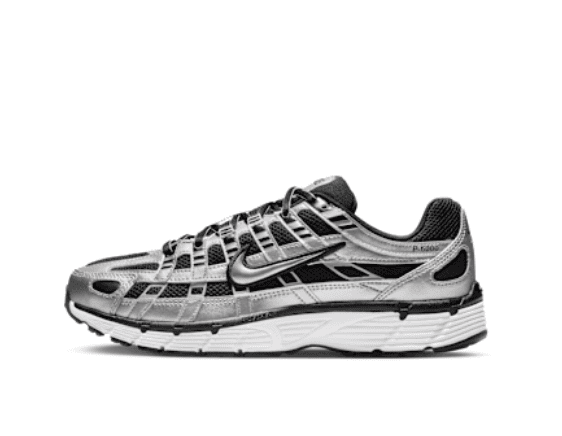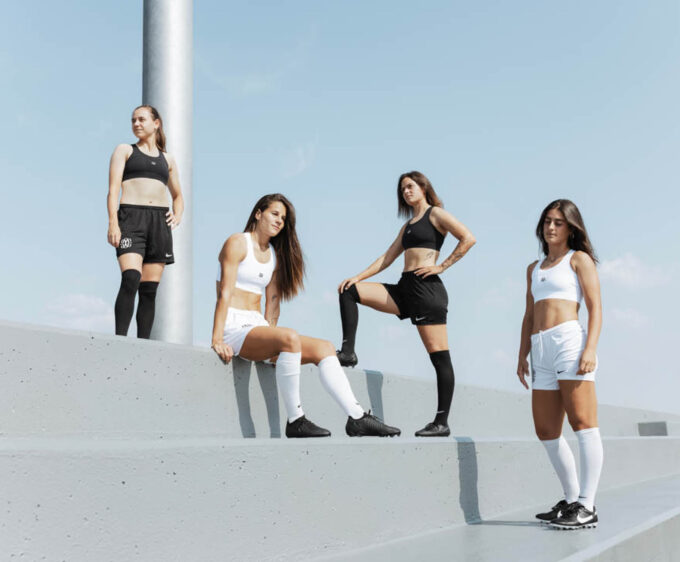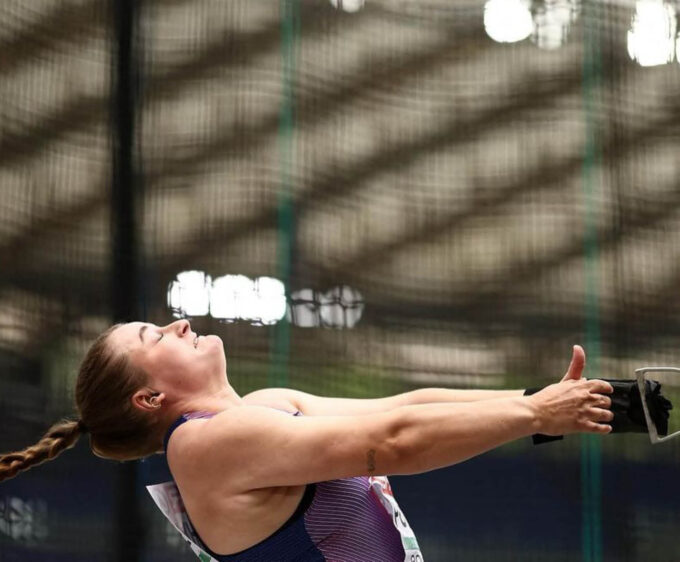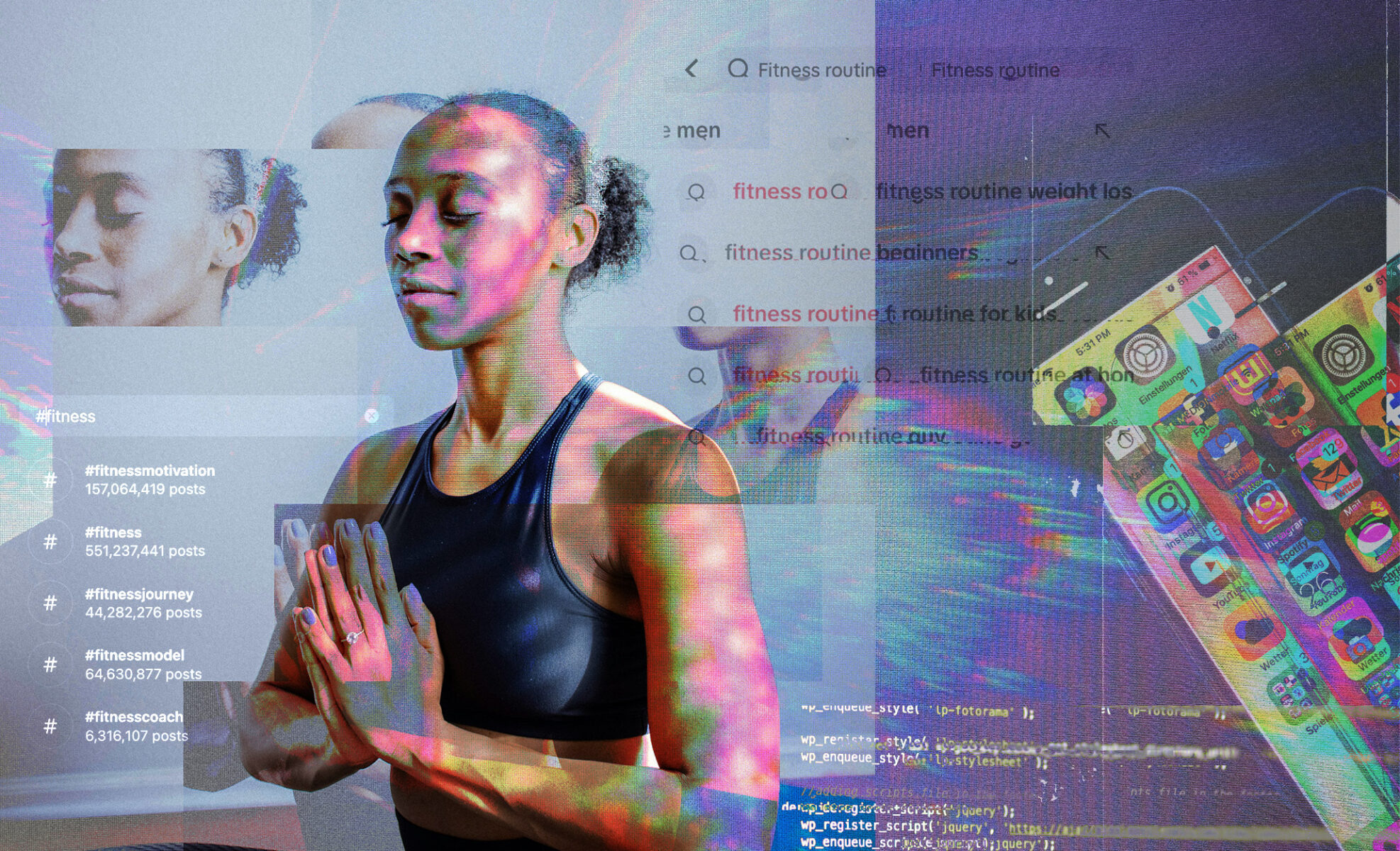
Workout by Algorithm?!
With platforms like Instagram and TikTok tailoring fitness content to your every click and scroll, are you truly choosing your fitness journey, or is an algorithm making the call for you?! Glorious investigates.
By Glorious
I’ve witnessed more than my fair share of fitness fads over the years. From the early 2000s home workout DVDs, the obsession over Gwyneth Paltrow and Madonna’s toned arms, the rise of spin, the invention of ‘prancercise’, and the surge of middle-aged women flocking to town halls for Zumba. The landscape has shifted dramatically, yet none of these trends compare to what we see today: a generation guided not just by their own fitness goals but by what their small, portable screens dictate. Algorithms, those invisible architects of our digital experiences, now shape how we exercise. As I reflect on this, I can’t help but wonder: am I truly choosing how to stay fit, or is an algorithm making that choice for me? Are my workouts driven by an intrinsic motivation to be healthier, or have I simply internalised the extrinsic motivations of what’s currently trending online?
Social media’s impact on modern life is profound and far-reaching, influencing everything from our purchasing decisions to our social interactions. Platforms like Instagram and TikTok have revolutionised how we discover and engage with fitness content, making them pivotal in shaping contemporary fitness trends. Algorithmic curation, the process by which content is filtered and personalised based on user behaviour, plays a significant role in this phenomenon. It tailors the content we see to align with our interests, often pushing us towards the latest trends and influencers. The rise of influencers and micro-influencers has been instrumental in this shift. Influencers, with their huge reach, and micro-influencers, with their hyper-engaged audiences, have become key players in the fitness world. Algorithmic curation amplifies their effectiveness at reaching and engaging with the relevant audiences, making them powerful trendsetters.

Gen Z, the digital natives born into this tech-driven world, represent a fascinating case study where they’ve embraced wellness in a way that Millennials never quite did. For them, fitness is not merely about looking good but is intertwined with mental health, longevity, and a holistic approach to well-being. A recent study by CivicScience shows that nearly 60% of Gen Z adults jog or run for fitness weekly, far surpassing the general population. Additionally, 48% exercise several times a week, demonstrating their strong commitment to physical health. This generation is hyper-aware of what they consume, both physically and mentally, and fitness plays a significant role in that awareness. In addition, their engagement with health and fitness has taken on new forms due to the digital-first landscape they grew up in. Platforms like TikTok make it easy for them to discover niche wellness practices that might have once seemed obscure. For instance, trends like “Hot Girl Walks” have gained immense popularity, showing how seemingly simple and achievable activities can resonate with a younger, tech-savvy audience who is bombarded with wellness content. The hashtag #HotGirlWalk has garnered over 700 million views on TikTok, highlighting its viral success (The Times, 2023). This idea of simplicity, combined with fitness, is one of the major drivers that makes platforms like TikTok so successful in shaping trends.
Unlike Millennials, who might have dragged themselves to the gym out of a sense of obligation, Gen Z approaches fitness with an enthusiasm that’s hard to ignore. For them, fitness is more than a routine; it’s a lifestyle. It’s not just about aesthetics but also about mental health, balance, and self-care. However, their fitness routines are shaped, sometimes subtly and sometimes overtly, by the platforms they use every day.
TikTok has emerged as a major player in this fitness revolution. The rise of “FitTok”—a section of TikTok dedicated entirely to fitness—has transformed how people discover and engage with workout trends. Hashtags like #Pilates, #GymTok, and #HomeWorkout rack up billions of views, with influencers producing short, catchy clips of everything from ‘Shy Girl Workouts’ to 10-minute ab routines. One particular trend that has captured attention is Reformer Pilates.
Once a niche and costly exercise favoured by the Hollywood elite, Pilates studios have now become a must-visit for young people, thanks largely to viral TikTok videos showcasing lean, toned bodies performing seemingly effortless stretches on machines. According to Class Pass, sculpt classes were the fastest-growing workout segment of 2022, with a 471% increase in bookings from January to October. Similarly, Les Mills’ 2023 Gen Z Fitness: Cracking the Code report showed strong appetite for the genre, with 63% of Gen Z exercisers enjoying Reformer Pilates, 57% doing Yoga, and 55% taking part in mat Pilates. This is no coincidence. TikTok’s algorithm is designed to learn user preferences and push content that aligns with those interests. Once someone starts interacting with fitness-related videos, the TikTok algorithm ensures that they are shown more of the same—Reformer Pilates, HIIT workouts, barre challenges, and beyond. This isn’t a passive process. TikTok doesn’t just recommend content; it creates viral moments that influence real-world behaviour.
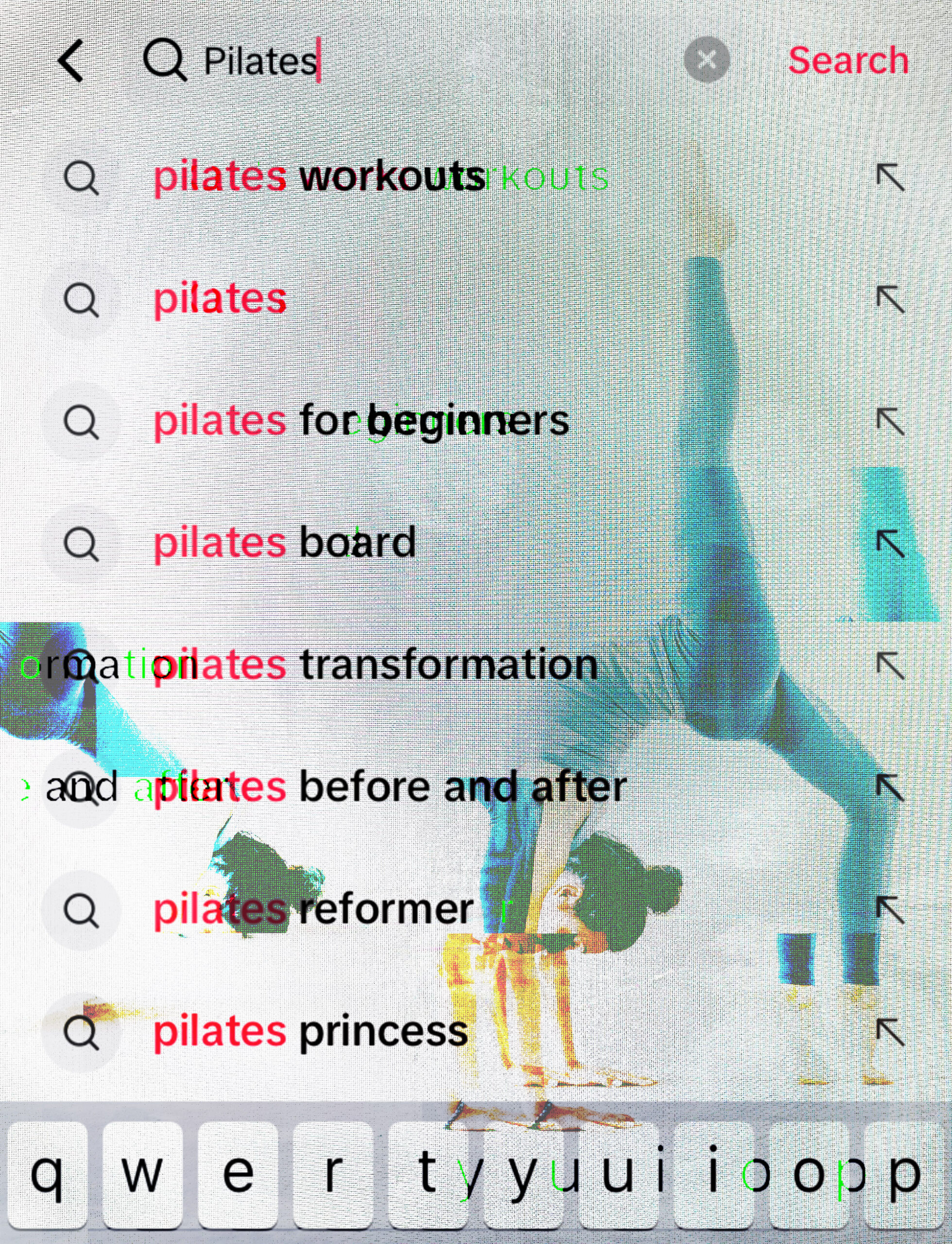
The rise of Reformer Pilates is just one example of how algorithms shape fitness trends. Alo Yoga, initially known for its luxury athleisure wear, has evolved into a wellness empire with the help of influencers. Founded in Los Angeles in 2007, the brand quickly became synonymous with high-end, fashion-forward yoga apparel, designed not just for the studio but for everyday wear. Over time, Alo expanded beyond clothing to encompass a broader wellness lifestyle, offering mindfulness practices, yoga classes (both in-person and online), skincare products, and wellness retreats. Walk down a busy high street in London or Luxembourg, Milan, or Miami, and chances are you’ll spot a fresh faced 20 something year old woman sporting an Alo tracksuit—despite the wearer often being nowhere near a studio. The small Alo logo has become a literal badge of membership, signalling the wearer is part of the ‘cool girl’ Alo club.
Take Brooke Scofield, a 27-year-old American influencer and podcaster who hosts the ‘Cancelled’ podcast with equally influential and sometimes controversial fellow influencer Tana Mongeau. Brooke frequently appears in her videos and podcasts dressed in full Alo Yoga tracksuits, discussing everything from dramatic personal stories to wild nights out.
These clips, with the distinctive ‘Alo’ logo prominently displayed on Brooke’s chest, garner millions of views. Brooke’s endorsement of the brand has attracted significant attention, prompting her to openly discuss her ‘obsession’ with Alo Yoga and share her experiences attending their exclusive classes. These studios, with their high-end athleisure stores and luxurious fitness spaces, embody not just a brand but an entire lifestyle. Engaging with these videos or clicking on the ‘@alo’ tag quickly immerses viewers in the Alo lifestyle, as the algorithm begins to serve more content aligned with this ‘Alo girl’ persona. While it appears that Brooke genuinely loves the brand, wears their clothes, and attends their studios, this is part of a broader, intricately crafted, algorithm-driven content cycle. This sharing, along with many other influencers expressing their affinity for the Alo ‘vibe’, has led to Alo Yoga’s gyms and fitness spaces attracting young people in droves. Once the algorithm detects a user’s interest in fitness content, it continuously feeds them the Alo aesthetic—one luxurious workout session at a time. According to The Guardian, Alo Yoga saw a 50% increase in online sales after heavily investing in influencer marketing and TikTok promotions.

attainable
Watched a few clips of tennis on YouTube, Instagram, or TikTok? Chances are, you’ll soon find yourself served content about tennis’s younger sister, padel, or the rapidly growing sport of pickleball. The influence of algorithms in propelling the popularity of these ‘new sports’ is undeniable. In recent years, padel has exploded across Europe, with over 20 million players globally, and is continuing its rapid expansion, as detailed in the Playtomic Global Padel Report 2024. Similarly, pickleball, with its enthusiastic North American fan base, has experienced a 40% increase in participation, now boasting nearly 5 million players in the U.S. alone (USA Pickleball, 2023).
This became evident when Glorious shared a video of a young pickleball player, competing alongside her seasoned and older partner, Judy, in a local tournament. They wiped the court clean with their younger opponents, sparking comments like, “Don’t underestimate Judy!” and “Great, now I’m into pickleball! Where can I play?”. I’d wager that everyone who watched, liked, or commented on the video was soon served a steady stream of pickleball content. Once someone engages and expresses an interest with content, Instagram takes note, ensuring their feed is filled with similar videos. It’s a prime example of how algorithms amplify niche activities, introducing them to new audiences and pushing content that resonates with emerging interests.
However, while algorithms undoubtedly make fitness more accessible and tailored, they also raise ethical questions about the extent of control we relinquish. One significant concern is the promotion of unhealthy or unrealistic fitness goals. Social media platforms often showcase the ‘ideal’ body type through influencers whose routines and physiques may not be attainable or sustainable for the average person. A study published in Body Image found that exposure to fitness influencers on platforms like Instagram and TikTok can lead to increased body dissatisfaction, especially among young women (Body Image, 2023). The algorithm’s relentless display of ‘perfect’ physiques can sometimes do more harm than good, feeding into insecurities rather than promoting balanced, healthy lifestyles.
And it’s not just TikTok or Instagram driving these trends. YouTube, the original home of at-home workouts, continues to play a pivotal role in shaping fitness habits. During the pandemic, Joe Wicks’s family-friendly workouts dominated feeds, and Chloe Ting’s two-week shred challenge became nearly unavoidable. Their sudden rise wasn’t solely due to the effectiveness of their routines. YouTube’s algorithm recognised the demand for short, no-equipment workouts tailored to small living spaces during lockdown (Pew Research Center, 2024), pushing them to millions of viewers worldwide
.
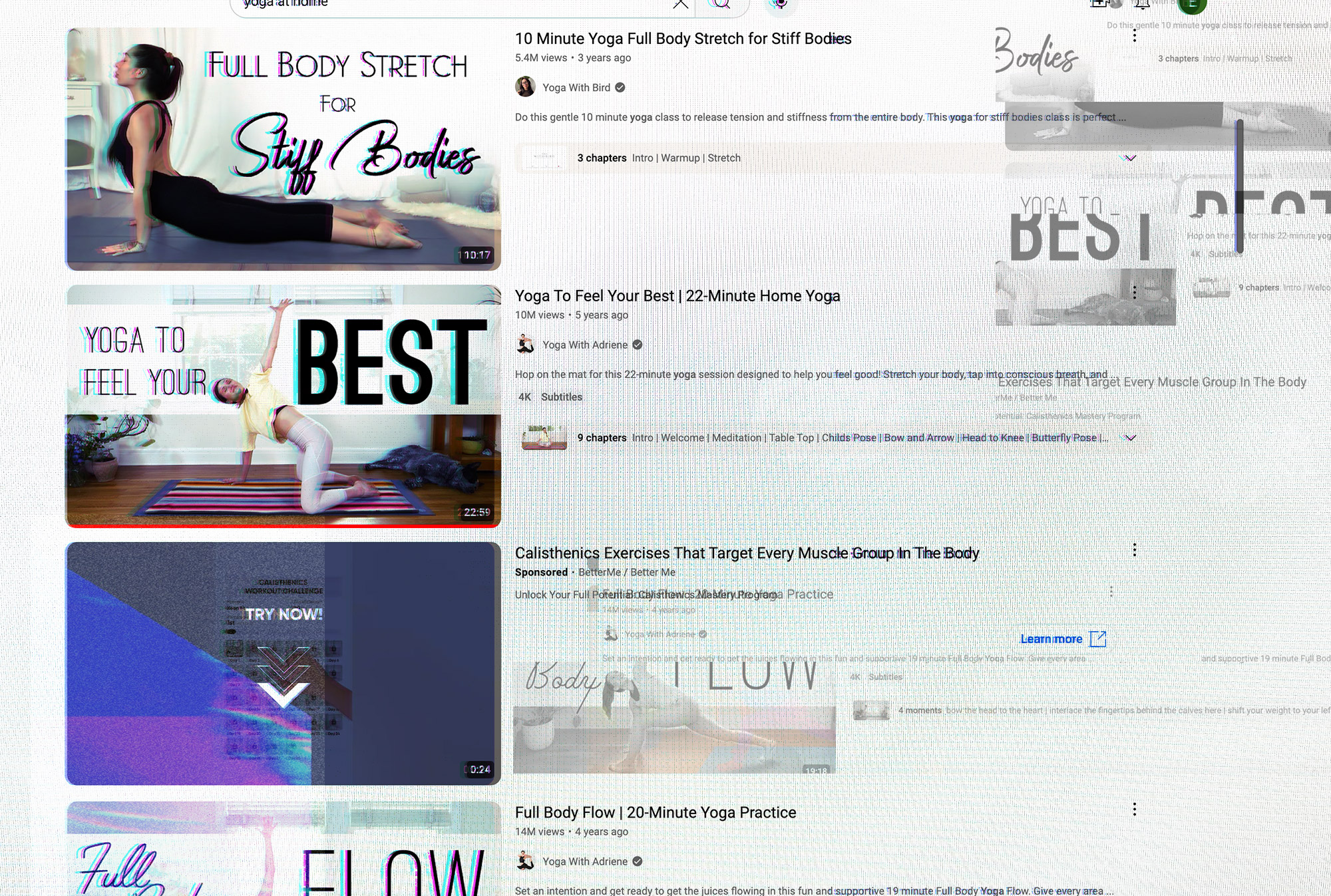
Reflecting on my own experience during the pandemic, I found myself turning to online fitness to stay active while gyms were closed. With her friendly face, calming tone, and 12 million followers, I couldn’t resist hopping on the ‘Yoga With Adriene’ bandwagon. Although I hadn’t actively searched for her, the algorithm kept nudging me towards her content, and one day, I finally clicked. That was it, I was hooked. The algorithm somehow seemed to know I had a vague interest in attempting yoga in my cramped flat, even though I hadn’t watched yoga videos before. To be honest, I’m glad it did – I honestly credit Adriene as one of the major factors that got me through living alone during lockdown one! Now, four years later, she’s still there, smiling from my YouTube ‘recommended’ page like an old friend. And yes, I still click on occasion!

Another positive example of the algorithm helping build lasting fitness habits is my friend Alex. Until 2022, she’d never been on a run. Her Instagram feed played a crucial role in changing that. Through tailored recommendations, she discovered the NHS funded Couch to 5K program—a beginner-friendly plan designed to build up running stamina over nine weeks. The Couch to 5K app has become a hub for a supportive online community where users share their progress, challenges, and successes. For Alex, this meant finding a new passion for running, discovering a network of like-minded individuals, and even meeting her partner—all thanks to the algorithm’s push. She completed the program, joined others running across Wanstead Flats every morning before work (many of whom were also doing Couch to 5K), and embraced a new lifestyle. The algorithm’s nudge helped Alex uncover her talent for running, forge new friendships, and find her community. It’s a perfect example of how algorithms can facilitate meaningful connections and foster positive, life-changing habits.
So, how does the algorithm manage to connect us with such tailored content? How does it sometimes know what we want to see, often before we actually know what we want to see? Research shows we spend, on average, over two hours a day on social media, and platforms like YouTube and TikTok continually learn and adjust content to keep us engaged (Pew Research Center, 2024). It’s all in the subtleties—it’s not just about whether you ‘like’ or comment on a video. Did you watch a video for more than five seconds? Read the comments section? Click on a hashtag? Even if you don’t actively engage with a post, the platform is still picking up on your behaviour. If you scroll away quickly, you’re signalling disinterest, while lingering suggests the opposite. This sophisticated data collection allows these platforms to predict and present content that aligns with your emerging interests, often before you’ve fully realised them yourself.
Scary, right? This data-driven approach has sparked a rise in de-influencing—a movement encouraging people to step away from the curated, perfect world of online content and seek out what genuinely works for them, rather than passively being fed it. De-influencing isn’t just about rejecting glossy, idealised fitness content; it also involves resisting the constant data collection that underpins these platforms. By stepping back from algorithms that track our every click and interaction, people are reclaiming some control over their choices and privacy. This trend highlights a growing awareness of how our digital footprints are used to shape our behaviours and preferences. Yet despite this movement, the 2024 fitness landscape remains heavily influenced by digital trends. From TikTok challenges to VR workouts, the line between the real and the digital is increasingly blurred. While some are opting out, thousands more dive into the next viral workout, driven by the algorithms that keep us endlessly scrolling and engaging.

This raises an important question: how much control do we really have over our fitness choices? As algorithms get more sophisticated, they’ll likely offer hyper-personalised workout plans based on deep analyses of our performance, lifestyle, and even genetic information (MIT Technology Review, 2024). Wearable tech, like fitness trackers, will continue collecting detailed data on activity, sleep, and health, refining our workouts in real-time. While this could make routines more efficient, it raises concerns. How comfortable are we with sharing such sensitive data? Would we want health providers accessing it? Maybe. But health insurers? Not so much. And employers? Absolutely not!
Virtual and augmented reality (VR and AR) are also set to play a bigger role in fitness. As these platforms grow, they’ll generate extensive data on user preferences, creating dynamic, personalised workouts that adapt in real-time (Virtual Reality Society, 2024). While this sounds like a fun way to stay fit, it also prompts questions about how algorithms will shape fitness trends and user experiences. Will these immersive experiences help us stay motivated, or will the endless push for engagement distract from our fitness goals?
Let’s not forget social media algorithms. As Instagram, YouTube, and TikTok evolve, their algorithms will likely play an even bigger role in dictating fitness trends. A report from Social Media Today suggests that these platforms will continue to push content based on our engagement habits, causing trends to rise and fall (Social Media Today, 2024). For example, the rise of the “lazy girl workout” is one of the latest viral trends, offering bite-sized fitness routines that appeal to users overwhelmed by more intense workouts. This surge in popularity wasn’t just due to a few influencers jumping on board—it was the algorithms recognising a demand for accessible, low-commitment routines and pushing them out en masse.
However, this future isn’t without its challenges. The flood of algorithm-driven content could make it harder to discern what’s genuinely useful versus what’s simply trending. Research from the Journal of Consumer Research suggests that constant exposure to curated content can lead to decision fatigue, leaving us less satisfied with our choices (Dr Sharon Gam, 2024). With fitness becoming more personalised, finding a balanced approach might get trickier. The constant barrage of fitness influencers, each promising the next ‘big thing,’ makes it easy to fall into the trap of jumping from one trend to another, never quite sticking with one long enough to see real progress.
motivated

So, is an algorithm shaping my workout? Absolutely. But I’m not alone—we’re all guided by these unseen forces, whether we realise it or not. The real question is how much control we’re willing to relinquish. Are we following the latest trend because we truly want to, or because the algorithm tells us we should?
As I sit scrolling through my phone, watching yet another ‘lazy girl 5 min workout’, I feel both grateful and slightly unnerved. Grateful because without these algorithms, I might never have found routines that suit my lifestyle. But unnerved because, for all the convenience, I wonder: how much of my fitness journey is really my own? Perhaps it’s time to ask ourselves that question more often.
Sources:
Civic Science (2022). 7 Quick Health & Fitness Trends That Lead Among Gen Z.
The Times (2023). The ‘Hot Girl Walk’ Became TikTok’s Favourite Exercise.
Class Pass (2022). 2022 ClassPass & Mindbody Look Back Report.
Les Mills (2023) Gen Z Fitness: Cracking the Code
The Guardian (2024). Alo Yoga Sees 50% Increase in Sales Thanks to TikTok and Influencers.
Playtomic (2024) Global Padel Report 2024.
USA Pickleball (2023) Annual Report.
Body Image (2023). The Effects of Fitness Influencers on Body Dissatisfaction Among Young Women.
Pew Research Center (2024). How the Pandemic Changed Fitness Habits on YouTube.
MIT Technology Review (2024). How Hyper-Personalised Workouts Could Shape the Future of Fitness.
Virtual Reality Society (2024). How Virtual and Augmented Reality Are Changing Fitness.
Social Media Today (2024). The Fitness Trends Algorithms Will Push in 2024.
Dr Sharon Gam (2024). Decision Fatigue and the Overload of Curated Content.
